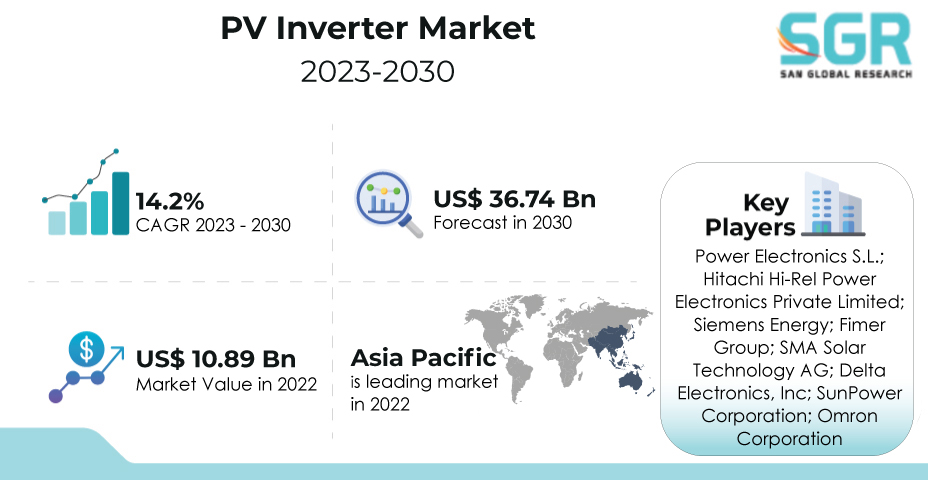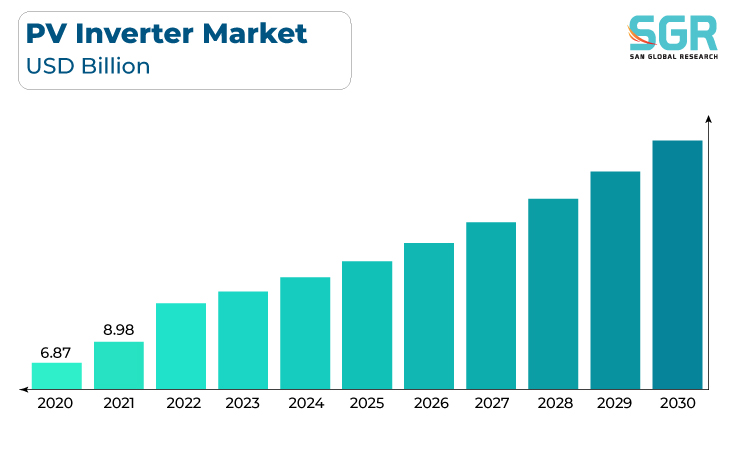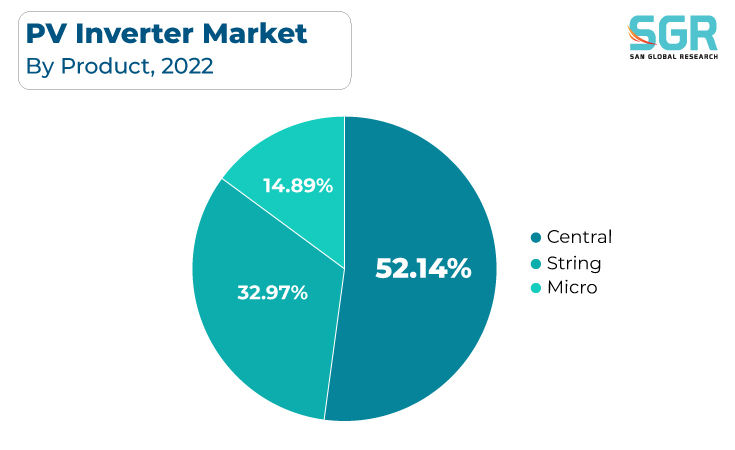Report Overview
The PV Inverter Market was valued at 10.89 Billion in 2022 and expected to grow at CAGR of 14.2% over forecast period.

The PV Inverter market is being propelled by a dynamic convergence of influential factors, emphasizing its critical role in advancing solar energy adoption and grid integration. The global push for sustainable and clean energy solutions fuels demand for photovoltaic (PV) systems, and inverters play an important role in converting solar-generated DC power into usable AC power.

Government incentives, renewable energy targets, and falling solar technology costs are accelerating the growth of PV installations, necessitating the use of efficient and reliable inverters to maximize energy conversion. Technological advancements in inverter design, efficiency, and grid management capabilities make the market more appealing. The trend toward decentralized energy systems, as well as the need for seamless integration of solar power into existing grids, contribute to the widespread use of PV inverters. Collaborations among technology developers, utilities, and regulatory bodies drive innovation, refining inverter technologies and infrastructure to ease the widespread adoption of solar energy and pave the way for a more sustainable energy future.
Product Outlook
Based on Product, the PV Inverter Market is segmented into Central, String, Micro. String Inverter segment accounted for largest share in 2022. String inverters play an important role in converting DC power from solar panels into AC power for consumption. String inverter design, efficiency, and reliability advancements all contribute to their growing popularity. The demand for cost-effective solutions, simplified maintenance, and scalability corresponds to the benefits provided by string inverters, particularly in residential and commercial installations. Collaborations between solar technology providers, utilities, and regulatory bodies promote innovation by refining string inverter technologies and enabling seamless integration of solar power into grids, thereby promoting the widespread adoption of sustainable energy solutions.

The global push for renewable energy sources drives the demand for efficient energy conversion, and central inverters are critical for converting DC power generated by PV arrays into usable AC power. Advances in central inverter design, grid management capabilities, and reliability make them more appealing for utility-scale projects. The need for cost-effective solutions, improved system performance, and simplified maintenance aligns with the benefits provided by central inverters, especially in utility-scale installations.
End-Use Outlook
Based on End-Use, PV Inverter Market is segmented into Commercial, Residential & Industrial, Utilities. Utility accounted for largest share in 2022. A dynamic interplay of factors is propelling the Utility PV Inverter market, emphasizing its critical role in driving the expansion of utility-scale solar projects and advancing renewable energy integration into the grid. The global imperative to shift to clean energy sources drives demand for efficient energy conversion, and utility inverters play a critical role in converting DC power generated by large photovoltaic (PV) arrays into grid-compatible AC power. Utility inverter design, capacity, and grid management capabilities have improved, making them more appealing for large-scale projects.
A dynamic array of factors drive the Commercial PV Inverter market, emphasizing its critical role in promoting solar energy adoption and efficiency in commercial-scale photovoltaic (PV) systems. Businesses are increasingly adopting solar power solutions due to an increased emphasis on sustainability and cost reduction, with commercial inverters playing a critical role in converting DC power from PV panels into usable AC power.
Regional Outlook
Asia Pacific is emerged as leading market for PV Inverter Market in 2022. Businesses are increasingly adopting solar power solutions due to an increased emphasis on sustainability and cost reduction, with commercial inverters playing a critical role in converting DC power from PV panels into usable AC power. Commercial inverter design, grid integration capabilities, and energy management advancements increase their appeal for a variety of commercial applications. The need for energy savings, dependable system performance, and seamless integration with existing infrastructure aligns with the advantages of commercial inverters, making them useful in optimizing energy consumption for businesses.
The North American PV Inverter market is being driven by a dynamic mix of factors that emphasize its critical role in advancing solar energy adoption and grid integration across the region. The increasing emphasis on clean energy solutions, combined with federal and state-level incentives, drives demand for photovoltaic (PV) installations, necessitating the use of reliable and efficient inverters. Advances in PV inverter design, grid compatibility, and energy storage capabilities are in line with the region's commitment to renewable energy. The need to reduce carbon emissions, optimize energy consumption, and improve grid resilience drives the use of PV inverters.

PV Inverter Market Report Scope
| Report Attribute | Details |
| Market Value in 2022 | USD 10.89 Billion |
| Forecast in 2030 | USD 36.74 Billion |
| CAGR | CAGR of 14.2% from 2023 to 2030 |
| Base Year of forecast | 2022 |
| Historical | 2018-2021 |
| Units | Revenue in USD million and CAGR from 2023 to 2030 |
| Report Coverage | Revenue forecast, Industry outlook, competitive landscape, growth factors, and trends |
| Segments Scope | By Product, By End-use, By Payor, and By Establishment |
| Regions Covered | North America, Europe, Asia Pacific, CSA and MEA |
| Key Companies profiled | Power Electronics S.L.; Hitachi Hi-Rel Power Electronics Private Limited; Siemens Energy; Fimer Group; SMA Solar Technology AG; Delta Electronics, Inc; SunPower Corporation; Omron Corporation; |
Global PV Inverter Market, Report Segmentation
PV Inverter Market, By Product
- Central
- String
- Micro
PV Inverter Market, By End-Use
- Commercial
- Residential & Industrial
- Utlities
PV Inverter Market, Regional Outlook
North America
- U.S.
- Canada
- Mexico
Europe
- Germany
- UK
- Spain
- Russia
- France
- Italy
Asia Pacific
- China
- Japan
- India
- South Korea
- Australia
CSA
- Brazil
- Argentina
MEA
- UAE
- Saudi Arabia
- South Africa

 Description
Description
 Table of Content
Table of Content
 Gera Imperium Rise,
Gera Imperium Rise,  +91 9209275355
+91 9209275355


